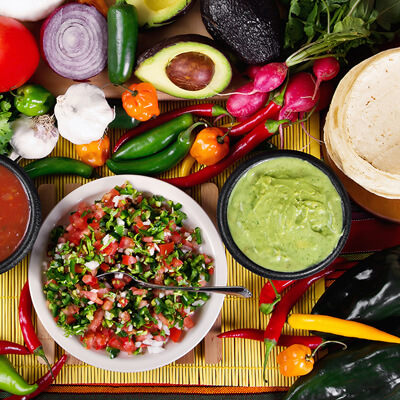
Hispanics/Latinos of Mexican descent living in the United States are disproportionately affected by non-alcoholic fatty liver disease (NAFLD), a risk factor for liver cancer. In a recent study, researchers analyzed data from 280 Hispanic/Latino adults of Mexican descent living in Southern Arizona (178 women, 102 men) who were overweight or obese to find out whether adherence to a traditional Mexican diet was related to lower hepatic steatosis and fibrosis.
The severity of NAFLD is determined by damage to the liver that prevents it from working properly. This damage ranges from hepatic steatosis, a buildup of fat in the liver, that can eventually worsen to liver fibrosis—which is the inflammation, scarring, and stiffening of the liver. Birthplace and dietary patterns, such as high intake of sugary foods and processed meat, are some factors that place Hispanic/Latino populations at highest risk for NAFLD. While research supports that certain types of diets can reduce the risk of developing hepatic steatosis or fibrosis, the role of a traditional Mexican diet and whether birthplace makes a difference in NAFLD risk have not been examined.
The study participants were aged 18 years to 64 years with a body mass index equal to or greater than 25 kg per square meters, self-identifying as being of Mexican descent, and reporting their birthplace as either being born in the United States or Mexico.
Participants were randomly contacted three times over a period of 2 weeks to provide a report of the quantity and portions of their food intake over the past 24 hours. Then, the researchers used this information to score participants’ diets, which included more traditional Mexican foods (e.g., corn tortillas, fruits, beans, nuts, rice, vegetables, poultry and eggs, fish, dairy products) and fewer foods more typical of an American diet (e.g., red and processed meats, refined grains other than rice, added sugars). This informed a score that showed how much a person’s diet pattern fit into traditional Mexican diet patterns. Participants were also evaluated for hepatic steatosis and fibrosis using a non-invasive, reliable type of ultrasound called Fibroscan®.
U.S.-born participants had diets that were the least traditional, and Mexico-born women had diets that were most traditionally Mexican. Having a more traditional Mexican diet was related to a lower risk of hepatic steatosis among participants who were U.S.-born. Every point increase in the more a diet was traditionally Mexican was related to a lower hepatic steatosis score by 5.7 points.
The researchers thus suggested that U.S.-born individuals of Mexican descent, especially those with unhealthy dietary patterns, may benefit from a reduced risk of NAFLD by following a more traditional Mexican diet. They concluded that a traditional Mexican diet holds promise in the prevention and management of NAFLD.
Page published Sept. 17, 2024

